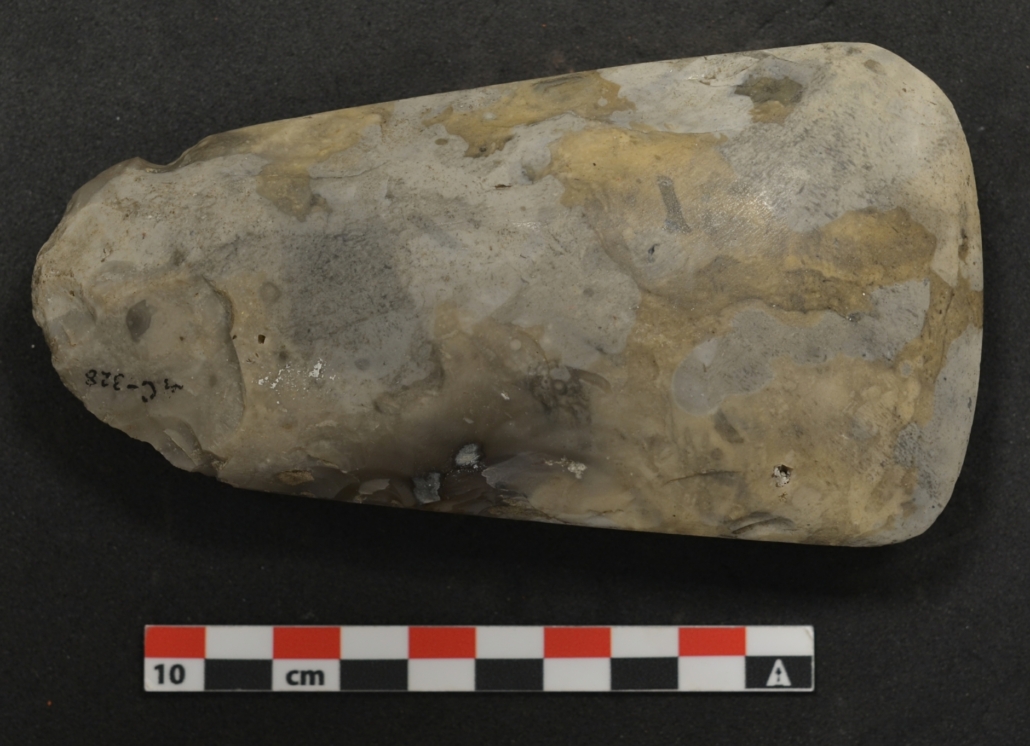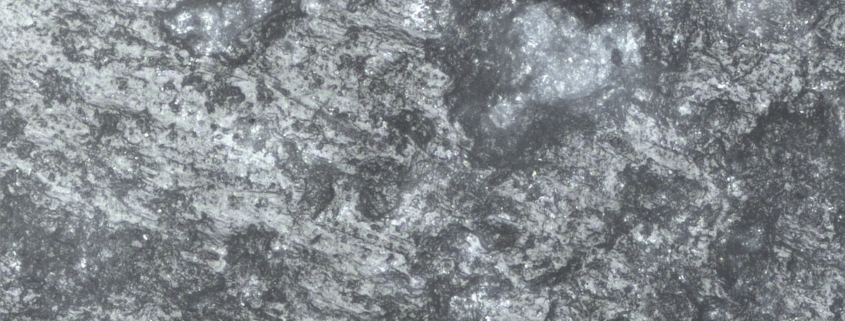How to finish your axes? Experiments with the final stages of the production of polished flint axes
Vlaardingen Culture sites often yield large quantities of polished axe fragments, and occasionally even complete axes are found. Microscopic analysis of these axes and notably these axe fragments indicated that there were marked differences in the production traces which could be observed. This came as a surprise because all these axes were imported from far away. The people of the Vlaardingen Culture didn’t produce flint axes, they imported them from flint mines in Belgium. It is always assumed that these axes were imported as finished objects (Bakker 2006).

Figure 1. Complete polished flint axe from Hekelingen III (Collection RMO Leiden).
To better understand the differences in production traces we decided to conduct a series of experiments where we would grind and polish flint using different methods. So far we conducted three experiments (see figure 2-4):
1. Grinding flint on a sandstone grinding stone with water;
2. Grinding flint on a sandstone grinding stone with water and coarse sand (0,6 mm);
3. Grinding flint on a sandstone grinding stone with water and fine sand (0,05-0,25 mm);
The experiments were added to the reference collection of the Material Culture Studies laboratory which already included two experiments with production traces on flint. Both experiments were conducted to polish flint using leather and fine sand (Van Gijn 2010; Wentink 2020). These experiments were conducted to replicate the production traces found on Corded Ware Culture (2900-2500 BC) axes. This method of polishing flint with leather and sand seemed to be a new introduction in this period as these traces were observed on Corded Ware Culture axes but not on Funnel Beaker Culture (3400-2900 BC) axes in the same region.
Preliminary results
So far the experiments confirmed our hypothesis that the different traces could be linked to different production methods. On one site we mainly found evidence for the grinding of flint on a grinding stone using water, sometimes with the addition of fine sand (see figure 4 & 5). On another site most axe flakes seemed to have been extensively polished using leather and fine sand (see figure 6 & 7).
These results however raised a lot of new questions:
– If all the flint axes come from the same flint sources in Belgium why do they yield different production traces?
– Is there a chronological difference indicating that the production methods for the production of these axes changed over time? Does this change run parallel with the change in production observed in the eastern Netherlands during the transition from the Funnel Beaker Culture tot the Corded Ware Culture?
– Did the final stages of production take place in the area of the Vlaardingen Culture instead of in Belgium, as it was previously assumed?
Literature
Bakker, J.A., 2006. The Buren axe and the cigar chisel. Striking export products from the West European flint mines – associations and distribution along their northern fringe, in: G. Körlin and G. Weisgerber (Eds.), Stone Age – Mining Age. Bochum: Deutsches Bergbau-Museum Bochum, 247-275.
Van Gijn, A.L., 2010. Flint in focus: lithic biographies in the Neolithic and Bronze Age, Leiden: Sidestone Press.
Wentink, K., 2020. Stereotype. The role of grave sets in Corded Ware and Bell Beaker funerary practices, Leiden: Sidestone Press.



 Yuri van Koeveringe
Yuri van Koeveringe